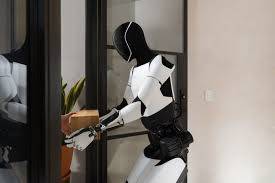Tesla's Optimus robot is a bold leap into the future of automation. First introduced by Elon Musk in 2021, Optimus is designed to handle dangerous, repetitive, and mundane tasks that people typically avoid or that pose safety risks. With its human-like appearance, Optimus stands 5'8" tall and weighs about 125 pounds. It’s powered by the same artificial intelligence technology used in Tesla’s self-driving cars, allowing it to understand its surroundings and interact with the world in a human-like manner.
The idea behind Optimus is to free people from tedious jobs, whether in factories, warehouses, or even at home. For example, in industrial settings, the robot could handle physically demanding tasks like lifting heavy objects, assembling products, and performing maintenance. In homes, it could potentially do chores like cooking, cleaning, and even taking care of the elderly or disabled. Optimus aims to be a versatile helper, capable of learning tasks much like a human worker would, using its advanced AI to adapt to different environments and challenges.
Optimus is built with several key features that make it stand out. Its AI allows it to perceive the world, navigate spaces, and perform tasks with human-like dexterity. Tesla designed it to move like a person, enabling it to work in environments created for humans. Safety is a priority—Optimus is limited in strength and speed to prevent accidents, ensuring it can’t harm the people around it. This careful design makes it a potential game changer in industries where automation has already been making significant strides.
Tesla’s primary goal for Optimus is to revolutionize the way labor is carried out. Currently, robots in factories tend to be specialized and rigid, built to perform one task repeatedly. Optimus, on the other hand, is designed to be adaptable and flexible, capable of performing a wide range of tasks. It can work alongside humans in areas like manufacturing and agriculture, handling tasks that are difficult, repetitive, or require precision. In logistics, it could help with moving goods, packing, and managing inventory efficiently. Essentially, Optimus could fill in wherever there’s a need for manual labor, helping to lower costs and improve productivity across many industries.
However, the road ahead is not without challenges. Creating a robot with the agility, dexterity, and problem-solving abilities of a human is an enormous technical feat. While Tesla has made significant progress in AI, replicating these abilities in a robot that can interact physically with the world is complex. There are also concerns about how this level of automation might impact jobs, especially in industries that rely heavily on manual labor. Furthermore, issues like privacy, data security, and the potential misuse of robots will need to be addressed as Optimus becomes more advanced.
Despite these hurdles, the potential of Tesla’s Optimus is vast. In the near future, it could become a common tool in industries that need automation to stay competitive. In the long term, it might even be used in space exploration, helping astronauts build infrastructure on Mars or perform tasks in harsh environments. While Optimus is still in development, the vision behind it is clear: a future where intelligent robots like Optimus work side by side with humans, taking on laborious tasks and opening new possibilities for innovation and exploration.


